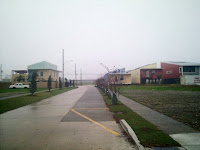Just as a disclaimer (and a healthy reminder to those of us who often don't recognize positions of privilege and how they affect the way we communicate and understand the world and ourselves), there is a principled difference between my experience of the Lower Ninth Ward and a locals experience of the Lower Ninth Ward (i.e.: I am white, the Lower Ninth is not; I wasn't here during Hurricane Katrina, many locals [if they did return] were). I'm talking about farming in this blogpost but there is much more history and soul to this place than growing vegetables on vacant lots.
______________________________________________________
 |
| The canal side of the levee. To the left is where the barge broke through and flooded the Lower Ninth during Hurricane Katrina. 15 feet in 6 seconds. |
I'm writing this from 2 feet beneath sea level. The house I am staying at was purchased last year and is currently under construction. Outside and across the street there is one occupied home, while beside it on either side there are a few vacant lots with an abandoned house a few lots further down. Down the road are more vacant lots, some maintained while others look like meadows or small farmers fields. Around the corner there are the Make It Right homes - futuristic-looking homes built by a post-Katrina not-for-profit. A couple blocks further is the levee which holds back the ocean from the neighbourhood.
______________________________________________________
 |
| The Lower Ninth Ward from the levee |
Living below sea level is a bit strange. You're not able to put it fully into perspective until noticing that all houses are built on concrete slabs because if they had basements they would act more like swimming pools. Or until you take a walk down the road and see the giant wall where the levee broke during Hurricane Katrina 8 years ago.
Post-Katrina, sections of the neighbourhood are being rebuilt in different ways. There are the Make It Right houses (an organization headed by Brad Pitt [here we call them Brad Pitt houses]), newly constructed and affordable shotgun houses, and then there are farms.
 |
| Reminds me of Detroit! (but with palm trees) |
A lot of people argue that the Lower Ninth Ward was a food desert long before Katrina hit. For anyone unfamiliar with the term "food desert" and how it fits into the context of the Lower Ninth, this video will give you a quick example. When the storm went through, it took with it the remaining small grocery stores. Today, within a 10 minute walk, there are two gas stations which mainly sell things like ready-made fried-chicken, beer, chocolate bars, and things like canned soup, peanut butter and instant oatmeal.
The other day I woke up and wanted to go out for a coffee. While living in any other city, this has never been much of an issue for me. Google Maps says it take 50 minutes to walk to the closest place to get a decent cup of coffee, and the closest supermarket is an 1 hour and 40 minute walk. As in any food desert, this all means that people who can't afford to drive / are overworked and unable to make the time commitment to get to a supermarket often don't make the trip. In turn, the food that people consume in food deserts is often lacking in nutrition and freshness - think of having instant oatmeal for breakfast, peanut butter and jam on white bleached bread for lunch, and canned soup for dinner. No fresh fruit or veggies.
I didn't make the trip to get the cup of coffee.
A lot of people say that Katrina offered the Lower Ninth Ward an opportunity to start from the ground up, to rebuild in a way that would have the issues of the past belong only to the past. Small farms and community gardens have popped throughout the Lower Ninth Ward because of the lack of nutritious and fresh produce nearby and abundance of vacant land since Katrina. The produce grown usually stays in the community, giving residents greater access to food.
 |
| Brad Pitt Houses |
 |
| Heather on a roof top |
 |
| One of the Capstone gardens, where I put some time in from time to time |

